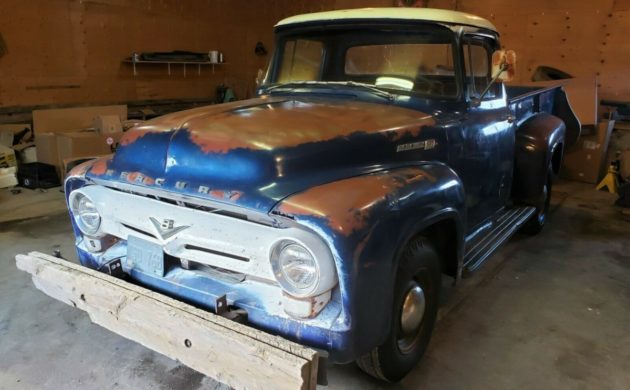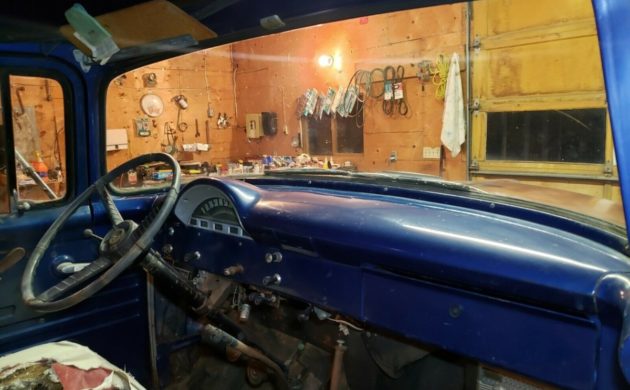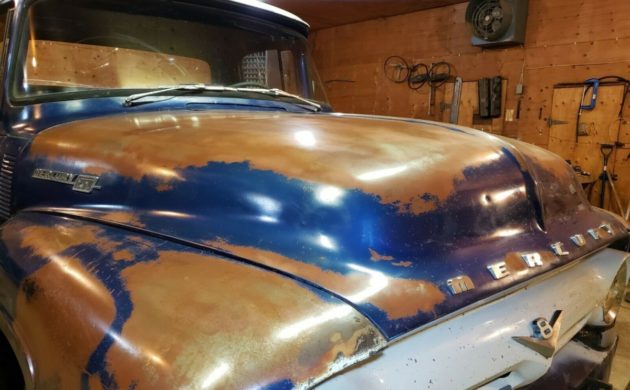These 1956 Mercury M250 trucks are already rare to begin with, just 6,959 were built in ’56, and this one has some features that make it even more unique, which we will discuss below. It is located in Sweet Grass, Montana and it was originally from Canada. There is no reserve and the truck has reached $4,000 at the time of writing by 33 bidders. The seller has listed 13,788 miles on the odometer and the title is clear. You can find it here on eBay.
Mechanically, the seller says the truck retains the original Y block V8 and manual transmission. The engine is said to turn freely and the tires are holding air, so it should be easy to move around. One of the more unique attributes about the truck is that it has a PTO hoist for a dump bed. Since it has this feature, the bed sits higher and the tailgate is missing. If you want a tailgate the seller will provide a 1956 F250 tailgate, or for an additional cost, they have a 1956 Mercury M100 tailgate.
Inside, other than the bench seat needing to be reupholstered, the cab is in good condition. Notes in the listing say that the truck has rust on the driver side front fender, above the headlight, and near the lower cowl. The paint is not in the best condition but it certainly gives the truck character. There are some graphics that you can see in one of the photos displaying the words “Canada agriculture” from what I can decipher.
If the price does not go much higher, and you know how to get this engine up and running, you can have a great truck in your garage. These sellers have sold many trucks on eBay and many of them have crossed this site. I know I’ve written about a handful of them myself. Having a PTO option is not something that you see on an older truck, especially a Mercury. Hopefully whoever purchases this truck does put it to use. It has so much potential.









Another gem from Hoser Country. I’m a little surprised to see a 3/4 ton with a hoist on it as 1-ton trucks were usually the ones to get that treatment. Either way 3/4 ton trucks were getting quite rare out west by ’56. Lots of 1/2 tons but there was quite a gap to the 2-ton trucks. With the farms getting larger there just wasn’t the demand for the larger light-duty trucks. Quite likely a 272 engine, which, if this truck came to my place, would stay. Overhaul it, add the extra lube plumbing to the valve train and keep on. No doubt the crossover exhaust pipe will need to be replaced; lots of rust-throughs. They did tend to rust out behind the headlights, even if situated in the chinook belt where they used very little salt of the roads. This truck could come to my place…
Geomechs, you mentioned this truck might have the 272 engine in it; I was helping a friend of mine with research on the ‘55 T-bird we hauled home from Los Banks for him. One of the sites had a 272 ci V8 listed as an option along with the 292 V8 which we think is the engine in his car, as I can’t find ANY mention of any T-bird with the 272.
Are these motors the same as that you thought might be in this truck?
Nevadahalfrack
Los BANOS!
According to the information I have the small Y-block (239-312) got to be somewhat of a mixed bag but I’ll give you the 25 cent version: 1954 introduced the 239 (Ford) / 256 (Mercury) engine. The 256 only lasted for one year before it was enlarged to 272. The 239 was the std. engine in Ford cars and light trucks in ’55 but the 272 was available in Mercury, and larger Ford trucks. Then there was the T-Bird which had an even larger engine, the 292. I think the 292 was the only engine that was offered in the Thunderbird for ’55. Come 1956 and the T-Bird got the 312. Someone in the Mercury side started to whine so they got the 312 as an option but it was toned down from the T-Bird. The 292 was optional in the Ford car. Some told me you could order a 312 in a ’56 Ford passenger car but I haven’t seen it in the information I’ve got. The ’56 light trucks were available with the 272, with the 292 optional in the larger trucks. Of course if you wanted to go Super Duty (F750/F850) you got the 317 Lincoln engine. 1957 got more confusing. Some told me that you could get a toned down 312 in the larger (F500/F600) trucks but I could only find a 292. As far as the T-Bird went the 312 was the only engine available in the T-Bird for ’57. Of course it was available in three ratings. Confused yet? I’ve been writing this and looking at my info and I’m totally confused. Anyway, I hope this helps. G
It does, geomechs and thank you.
Welcome, Nevada.
Geomechs, I drove a 2-ton 56 Ford with a 10-yard dump box and a 272 engine for a few years working for my uncle. Talk about underpowered! It was equipped with an Eaton-Spicer 2 speed rear end, and he later added a Brownie auxiliary transmission. Gear selection was interesting, to say the least.
That would have made you a real gear-jammer. My uncle had a ‘58 F600 with a 292/5 spd and 2-speed Eaton. It could handle 250 bushels of wheat although it couldn’t come ‘out of the hole’ as easily as Dad’s ‘51 International L-160. But on the road the Ford made 55 quite easily.
Very cool, geomechs is correct about getting oil to the valve-train.
We had several Y-Blocks in the family years ago – from 239 to 312 ci and they all ended up with a valve train oiler kit.
(Hollow stud with an oil line.)
Excellent information and well appreciated. My father was HS class of ’63 driving a 1955 T-bird, 292. Always contended 312 was a Lincoln motor (yeah dad, ‘Hot Rod Lincoln’ by Commander Cody and the Lost Planet Airmen).
Recently found a feature documentary about the 1932 Ford V8 that is worth watching. No one believed at the time a block of it’s kind could be made from a single casting. All about determination in the toughest of times. Mistakes were made and corrected.
Appreciate the write up and the knowledge of the member comments above !
That feature on the ‘32 Flathead, did that happen to be on YouTube? That is a good program.
Send it back to Canada – – it’s part of our heritage eh – – –
Go get it and take it home, brother!
Always enjoy seeing the latest offering from the border brothers. If you think about it, they are buying in Canadian dollars and selling in US dollars, they are up 33 percent before they turn a wheel. It’s the classic arbitrage trade – old as the British tea routes from the orient. I’ll call it CARbitrage. Feel free to use that.